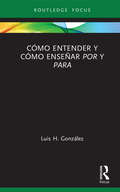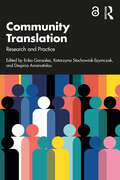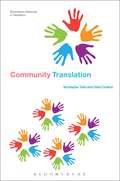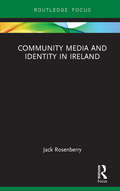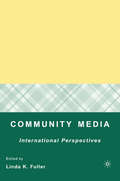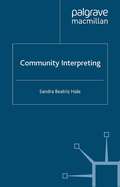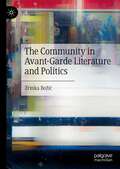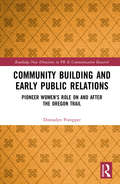- Table View
- List View
Cómo entender y cómo enseñar por y para
by Luis H. GonzálezCómo entender y como enseñar por y para explora muchos de los problemas que los profesores/as encuentran cuando enseñan el uso de estas dos preposiciones. Este libro proporciona un marco de referencia para la comprensión de las sutilezas entre las dos preposiciones, de manera que los profesores/as podrán ayudarles a los estudiantes a aproximarse a la manera cómo los hablantes nativos/as escogen intuitivamente cuál usar en cualquier situación. Este libro muestra con ejemplos de cuatro autores/as distintos que una regla de punto final intencional (destino, fecha límite, meta, objetivo, propósito, recipiente o uso) explica el 95% de los usos de para. Trescientos ejemplos de Corpes XXI y otros 262 ejemplos de tres novelas distintas muestran que dos reglas (causa e intervalo de espacio/de tiempo) explican el 80% de los usos de por. En este libro no se ejemplifican las reglas; más bien, se formulan desde abajo las reglas necesarias para explicar más de 600 ejemplos auténticos de por o para de novelas y de Corpes XXI. Diseñado para los profesores/as de español como segunda lengua, el procedimiento de construcción de las reglas delineado en el libro mejorará la manera cómo se les enseñará a los estudiantes por y para. Además, las conexiones hechas a través del libro servirán como un modelo para entender mejor otras dicotomías de la gramática del español.
Community Writing: Researching Social Issues Through Composition
by Paul S. CollinsCommunity Writing: Researching Social Issues Through Composition employs a series of assignments that guide students to research and write about issues confronting their individual communities. Students start by identifying a community to which they belong and focusing on problems in it, and then analyze possible solutions, construct arguments for them, decide which are likely to succeed, and consider how to initiate action. This is a primary text for first-year composition courses, covering the basics of the writing process. The assignments are recursive. Short writing assignments in each chapter build up to longer papers. Each of the assignment questions is accompanied by a guide to thinking about and writing the assigned paper, followed by a short Focus On reading that provides a brief account of community activism, a media case study, or a notable success story. The longer papers are accompanied by in-class peer reading groups. Each successive peer reading attempts a higher level of conceptual critique. By working together throughout the semester, students create increasingly adept peer groups familiar with all stages of each other's research. The book is carefully structured, but there is plenty of "give" in it, allowing instructors to be flexible in adapting it to the needs of their students and courses. Community Writing: * is distinguished by pedagogy based on a collaborative, process-oriented, service learning approach that emphasizes media critique and field research on community issues chosen by individual students; * answers real student questions, such as: Where do I find articles on my topic? What if evidence contradicts my hypothesis? How do I know if a source is biased?; * is web-savvy--guides students into building their own Web sites, including a unique guide for critiquing the design and veracity of other people's websites; and * is media-savvy--topics include media monopolies, spin control, dumbing down, misleading statistics, the Freedom of Information Act, "crackpot" authors, political rhetoric, and fallacious argumentation.
Community Writing: Researching Social Issues Through Composition
by Paul S. CollinsCommunity Writing: Researching Social Issues Through Composition employs a series of assignments that guide students to research and write about issues confronting their individual communities. Students start by identifying a community to which they belong and focusing on problems in it, and then analyze possible solutions, construct arguments for them, decide which are likely to succeed, and consider how to initiate action. This is a primary text for first-year composition courses, covering the basics of the writing process. The assignments are recursive. Short writing assignments in each chapter build up to longer papers. Each of the assignment questions is accompanied by a guide to thinking about and writing the assigned paper, followed by a short Focus On reading that provides a brief account of community activism, a media case study, or a notable success story. The longer papers are accompanied by in-class peer reading groups. Each successive peer reading attempts a higher level of conceptual critique. By working together throughout the semester, students create increasingly adept peer groups familiar with all stages of each other's research. The book is carefully structured, but there is plenty of "give" in it, allowing instructors to be flexible in adapting it to the needs of their students and courses. Community Writing: * is distinguished by pedagogy based on a collaborative, process-oriented, service learning approach that emphasizes media critique and field research on community issues chosen by individual students; * answers real student questions, such as: Where do I find articles on my topic? What if evidence contradicts my hypothesis? How do I know if a source is biased?; * is web-savvy--guides students into building their own Web sites, including a unique guide for critiquing the design and veracity of other people's websites; and * is media-savvy--topics include media monopolies, spin control, dumbing down, misleading statistics, the Freedom of Information Act, "crackpot" authors, political rhetoric, and fallacious argumentation.
Community Translation: Research and Practice
by Erika Gonzalez Katarzyna Stachowiak-Szymczak Despina AmanatidouCommunity translation or public service translation is on a global scale often unregulated and dependent on individual awareness, good will and even charity work. The social impact and mission of community translation, the key role of the translator’s psycho-sociocultural awareness and its role depending on local and global changes in human migration and linguistic diversity make community translation a constantly evolving and yet under-investigated activity and profession. This book covers key practical and theoretical approaches towards community translation, providing insights into the current state of the field and the latest research, trends, guidelines, initiatives and gaps. Combining knowledge in the areas of translator ethics, pedagogy, legal, and social and health-related settings, this volume covers community translation in a wide range of countries and regions. Community Translation: Research and Practice is an essential guide both for those studying and working in this area worldwide. This volume is a springboard for further studies and research in this emerging field.
Community Translation: Research and Practice
by Erika González Katarzyna Stachowiak-Szymczak Despina AmanatidouCommunity translation or public service translation is on a global scale often unregulated and dependent on individual awareness, good will and even charity work. The social impact and mission of community translation, the key role of the translator’s psycho-sociocultural awareness and its role depending on local and global changes in human migration and linguistic diversity make community translation a constantly evolving and yet under-investigated activity and profession. This book covers key practical and theoretical approaches towards community translation, providing insights into the current state of the field and the latest research, trends, guidelines, initiatives and gaps. Combining knowledge in the areas of translator ethics, pedagogy, legal, and social and health-related settings, this volume covers community translation in a wide range of countries and regions. Community Translation: Research and Practice is an essential guide both for those studying and working in this area worldwide. This volume is a springboard for further studies and research in this emerging field.
Community Translation (Bloomsbury Advances in Translation)
by Mustapha Taibi Uldis OzolinsInvestigating an important field within translation studies, Community Translation addresses the specific context, characteristics and needs of translation in and for communities. Traditional classifications in the fields of discourse and genre are of limited use to the field of translation studies, as they overlook the social functions of translation. Instead, this book argues for a classification that cuts across traditional lines, based on the social dimensions of translation and the relationships between text producers and audiences.Community Translation discusses the different types of texts produced by public authorities, services and individuals for communities that need to be translated into minority languages, and the socio-cultural issues that surround them. In this way, this book demonstrates the vital role that community translation plays in ensuring communication with all citizens and in the empowerment of minority language speakers by giving them access to information, enabling them to participate fully in society.
Community Translation (Bloomsbury Advances in Translation #2)
by Mustapha Taibi Uldis OzolinsInvestigating an important field within translation studies, Community Translation addresses the specific context, characteristics and needs of translation in and for communities. Traditional classifications in the fields of discourse and genre are of limited use to the field of translation studies, as they overlook the social functions of translation. Instead, this book argues for a classification that cuts across traditional lines, based on the social dimensions of translation and the relationships between text producers and audiences.Community Translation discusses the different types of texts produced by public authorities, services and individuals for communities that need to be translated into minority languages, and the socio-cultural issues that surround them. In this way, this book demonstrates the vital role that community translation plays in ensuring communication with all citizens and in the empowerment of minority language speakers by giving them access to information, enabling them to participate fully in society.
Community, Myth and Recognition in Twentieth-Century French Literature and Thought (Continuum Literary Studies)
by Nikolaj LübeckerTaking as its point of departure the notion of community in mid-twentieth century French literature and thought, this ambitious study seeks to uncover the ways in which Breton, Bataille, Sartre and Barthes used literature and art to engage with the question of reconceptualizing society. In exploring the relevance these writings hold for contemporary debates about community, Lubecker argues for the continuing social importance of literary studies. Throughout the book, he suggests that literature and art are privileged fields for confronting some of the anti-social desires situated at the periphery of human rationality. The authors studied put to work the concepts of Thanatos, sado-masochism and (self-)sacrifice; they also write more poetically about man's attraction to Silence, the Night and the Neutral. Many sociological discourses on the question of community tend to marginalize the drives inherent within these concepts; Lubecker argues it is essential to take these drives into account when theorising the question of community, otherwise they may return in the atavistic form of myths. Moreover if handled with care and attention they can prove to be a resource.
Community, Myth and Recognition in Twentieth-Century French Literature and Thought (Continuum Literary Studies)
by Nikolaj LübeckerTaking as its point of departure the notion of community in mid-twentieth century French literature and thought, this ambitious study seeks to uncover the ways in which Breton, Bataille, Sartre and Barthes used literature and art to engage with the question of reconceptualizing society. In exploring the relevance these writings hold for contemporary debates about community, Lubecker argues for the continuing social importance of literary studies. Throughout the book, he suggests that literature and art are privileged fields for confronting some of the anti-social desires situated at the periphery of human rationality. The authors studied put to work the concepts of Thanatos, sado-masochism and (self-)sacrifice; they also write more poetically about man's attraction to Silence, the Night and the Neutral. Many sociological discourses on the question of community tend to marginalize the drives inherent within these concepts; Lubecker argues it is essential to take these drives into account when theorising the question of community, otherwise they may return in the atavistic form of myths. Moreover if handled with care and attention they can prove to be a resource.
Community Media and Identity in Ireland (Routledge Focus on Media and Cultural Studies)
by Jack RosenberryThis book explores how Ireland’s community media outlets reflect and shape identity at the local level. While aspects of its culture date back centuries, the nation-state of Ireland is less than one hundred years old. Because of this and other elements of the island’s history, Irish identity is a contested topic and the island is a place where culture, identity and geography are tightly intertwined. By addressing how community media serve as agents for community building, the book examines how they in turn influence the way individuals connect with their communities.
Community Media and Identity in Ireland (Routledge Focus on Media and Cultural Studies)
by Jack RosenberryThis book explores how Ireland’s community media outlets reflect and shape identity at the local level. While aspects of its culture date back centuries, the nation-state of Ireland is less than one hundred years old. Because of this and other elements of the island’s history, Irish identity is a contested topic and the island is a place where culture, identity and geography are tightly intertwined. By addressing how community media serve as agents for community building, the book examines how they in turn influence the way individuals connect with their communities.
Community Media: International Perspectives
by Linda K. FullerDrawing on case studies, this collection offers international perspectives on how community media serves their audiences. The contributors present perspectives on the ever-burgeoning area of grassroots. Their research represents participant observation, hands-on community involvement, boards of directors, content analysis, and ethical inquiries.
Community-Making in Early Stuart Theatres: Stage and audience
by Helen Wilcox Anthony W. Johnson Roger D. SellTwenty-two leading experts on early modern drama collaborate in this volume to explore three closely interconnected research questions. To what extent did playwrights represent dramatis personae in their entertainments as forming, or failing to form, communal groupings? How far were theatrical productions likely to weld, or separate, different communal groupings within their target audiences? And how might such bondings or oppositions among spectators have tallied with the community-making or -breaking on stage? Chapters in Part One respond to one or more of these questions by reassessing general period trends in censorship, theatre attendance, forms of patronage, playwrights’ professional and linguistic networks, their use of music, and their handling of ethical controversies. In Part Two, responses arise from detailed re-examinations of particular plays by Shakespeare, Chapman, Jonson, Beaumont and Fletcher, Cary, Webster, Middleton, Massinger, Ford, and Shirley. Both Parts cover a full range of early-Stuart theatre settings, from the public and popular to the more private circumstances of hall playhouses, court masques, women’s drama, country-house theatricals, and school plays. And one overall finding is that, although playwrights frequently staged or alluded to communal conflict, they seldom exacerbated such divisiveness within their audience. Rather, they tended toward more tactful modes of address (sometimes even acknowledging their own ideological uncertainties) so that, at least for the duration of a play, their audiences could be a community within which internal rifts were openly brought into dialogue.
Community-Making in Early Stuart Theatres: Stage and audience
by Helen Wilcox Anthony W. Johnson Roger D. SellTwenty-two leading experts on early modern drama collaborate in this volume to explore three closely interconnected research questions. To what extent did playwrights represent dramatis personae in their entertainments as forming, or failing to form, communal groupings? How far were theatrical productions likely to weld, or separate, different communal groupings within their target audiences? And how might such bondings or oppositions among spectators have tallied with the community-making or -breaking on stage? Chapters in Part One respond to one or more of these questions by reassessing general period trends in censorship, theatre attendance, forms of patronage, playwrights’ professional and linguistic networks, their use of music, and their handling of ethical controversies. In Part Two, responses arise from detailed re-examinations of particular plays by Shakespeare, Chapman, Jonson, Beaumont and Fletcher, Cary, Webster, Middleton, Massinger, Ford, and Shirley. Both Parts cover a full range of early-Stuart theatre settings, from the public and popular to the more private circumstances of hall playhouses, court masques, women’s drama, country-house theatricals, and school plays. And one overall finding is that, although playwrights frequently staged or alluded to communal conflict, they seldom exacerbated such divisiveness within their audience. Rather, they tended toward more tactful modes of address (sometimes even acknowledging their own ideological uncertainties) so that, at least for the duration of a play, their audiences could be a community within which internal rifts were openly brought into dialogue.
Community Literacies as Shared Resources for Transformation (Expanding Literacies in Education)
by Joanne Larson George H. MosesThrough multiple narratives reflecting the complexity of participatory action research partnerships for social justice, this book sheds light on the dialogic spaces that intentionally support community literacies and rhetorical practices for inquiry and change. Applying literacy as social practice, Larson and Moses tell a story of a unique collaboration between community members and university faculty and students, who together transformed an urban corner store into a cornerstone of the community. Building on the emerging field of community literacies, the book captures the group’s active work on the ground and, on another level, how transformation occurred in the dialogic spaces of the research team as it learned to embrace distributed expertise and multiple identities.
Community Literacies as Shared Resources for Transformation (Expanding Literacies in Education)
by Joanne Larson George H. MosesThrough multiple narratives reflecting the complexity of participatory action research partnerships for social justice, this book sheds light on the dialogic spaces that intentionally support community literacies and rhetorical practices for inquiry and change. Applying literacy as social practice, Larson and Moses tell a story of a unique collaboration between community members and university faculty and students, who together transformed an urban corner store into a cornerstone of the community. Building on the emerging field of community literacies, the book captures the group’s active work on the ground and, on another level, how transformation occurred in the dialogic spaces of the research team as it learned to embrace distributed expertise and multiple identities.
Community Interpreting (Research and Practice in Applied Linguistics)
by S. HaleThis is a comprehensive overview of the field of Community Interpreting. It explores the relationship between research, training and practice, reviewing the main theoretical concepts, describing the main issues surrounding the practice and the training of interpreters, and identifying areas of much needed research in answering those issues.
Community Informatics Design Applied to Digital Social Systems: Communicational Foundations, Theories and Methodologies (Translational Systems Sciences #12)
by Pierre-Léonard Harvey Virginie BuccoThis book introduces a Digital Social System Praxis Framework (DSSPF) integrating Computational Media, Evolutionary Systems Thinking and Design Thinking approaches to E-transformation practice, also called Community Informatics Design (CID). The DSSPF framework is intended to create communication spaces dedicated to knowledge production and sharing for social and organizational change. It allows social systems researchers and practitioners to recognize their synergistic roles in the praxis process to shape their future through social innovation projects. This transdisciplinary text provides potential students and practitioners fundamental concepts and tools for such design. It offers resources from the Pragmatic and Systemic philosophy of science for the co-construction of social architectures and infrastructures, and multi-aspectual design methodologies by which government, organizations and civil society can learn to ethically co-design common ground. This approach provides complementary and common patterns from known methods, models, and theories of social systems interventions that could support a generic framing of large scale sociotechnical systems: digital social innovation ecosystem, living Labs, Fab Labs, enterprise collaborative networks.There will be a particular focus on understanding and addressing the dimensions that make people from different communities of practice able to communicate and collaborate through multiple digital media, design platforms, worldviews and modeling approaches.
Community in Twentieth-Century Fiction
by Paula Martín Salván, Gerardo Rodríguez Salas and Julián Jiménez HeffernanThis book focuses on the imaginary construction and deconstruction of human communities in modern and contemporary fiction. Drawing on recent theoretical debate on the notion of community (Nancy, Blanchot, Badiou, Esposito), this collection examines narratives by Joyce, Mansfield, Davies, Naipaul, DeLillo, Atwood and others.
Community in Contemporary British Fiction: From Blair to Brexit
by Sara Upstone and Peter ElyExamining how British writers are addressing the urgent matter of how we form and express group belonging in the 21st century, this book brings together a range of international scholars to explore the ongoing crises, developments and possibilities inherent in the task of representing community in the present. Including an extended critical introduction that positions the individual chapters in relation to broader conceptual questions, chapters combine close reading and engagement with the latest theories and concepts to engage with the complex regionalities of the United Kingdom, with representation of writers from all parts of the UK including Northern Ireland. Including specific focus on the most challenging issues for community in the past five years, notably Brexit and the Covid-19 crisis, with a broader understanding of themes of local and national belonging, this book offers detailed discussions of writers including Ali Smith, Niall Griffiths, John McGregor, Max Porter, Amanda Craig, Bernadine Evaristo, Jonathan Coe, Bernie McGill, Jan Carson, Guy Gunaratne, Anthony Cartright, Barney Farmer, Maggie Gee and Sarah Hall. Demonstrating some of the resources that literature can offer for a renewed understanding of community, this book is essential reading for anyone interested in how British Literature contributes to our understanding of society in both the past and present, and how such understanding can potentially help us to shape the future.
Community in Contemporary British Fiction: From Blair to Brexit
Examining how British writers are addressing the urgent matter of how we form and express group belonging in the 21st century, this book brings together a range of international scholars to explore the ongoing crises, developments and possibilities inherent in the task of representing community in the present. Including an extended critical introduction that positions the individual chapters in relation to broader conceptual questions, chapters combine close reading and engagement with the latest theories and concepts to engage with the complex regionalities of the United Kingdom, with representation of writers from all parts of the UK including Northern Ireland. Including specific focus on the most challenging issues for community in the past five years, notably Brexit and the Covid-19 crisis, with a broader understanding of themes of local and national belonging, this book offers detailed discussions of writers including Ali Smith, Niall Griffiths, John McGregor, Max Porter, Amanda Craig, Bernadine Evaristo, Jonathan Coe, Bernie McGill, Jan Carson, Guy Gunaratne, Anthony Cartright, Barney Farmer, Maggie Gee and Sarah Hall. Demonstrating some of the resources that literature can offer for a renewed understanding of community, this book is essential reading for anyone interested in how British Literature contributes to our understanding of society in both the past and present, and how such understanding can potentially help us to shape the future.
The Community in Avant-Garde Literature and Politics
by Zrinka BožićThis book rethinks the concept of community taking Jean-Luc Nancy’s influential essay “La communauté désoeuvrée” as its starting point, tracing subsequent scholarship on community and adding new insights on avant-garde aesthetics and politics. Extensively exploring the communitarian dimension of avant-garde aesthetics and politics (focusing on artistic groups, intellectual circles and theoretical collectives), the author aims to bring literature and art into a philosophical examination of the paradoxical and complex idea of community.
Community Building and Early Public Relations: Pioneer Women’s Role on and after the Oregon Trail (Routledge New Directions in PR & Communication Research)
by Donnalyn PompperFrom the start, women were central to a century of westward migration in the U.S. Community Building and Early Public Relations: Pioneer Women’s Role on and after the Oregon Trail offers a path forward in broadening PR's Caucasian/White male-gendered history in the U.S. Undergirded by humanist, communitarian, critical race theory, social constructionist perspectives, and a feminist communicology lens, this book analyzes U.S. pioneer women's lived experiences, drawing parallels with PR's most basic functions – relationship-building, networking, community building, boundary spanning, and advocacy. Using narrative analysis of diaries and reminiscences of women who travelled 2,000+ miles on the Oregon Trail in the mid-to-late 1800s, Pompper uncovers how these women filled roles of Caretaker/Advocate, Community Builder of Meeting Houses and Schools, served a Civilizing Function, offered Agency and Leadership, and provided Emotional Connection for Social Cohesion. Revealed also is an inevitable paradox as Caucasian/White pioneer women’s interactional qualities made them complicit as colonizers, forever altering indigenous peoples’ way of life. This book will be of interest to undergraduate and graduate PR students, PR practitioners, and researchers of PR history and social identity intersectionalities. It encourages us to expand the definition of PR to include community building, and to revise linear timeline and evolutionary models to accommodate voices of women and people of color prior to the twentieth century.
Community Building and Early Public Relations: Pioneer Women’s Role on and after the Oregon Trail (Routledge New Directions in PR & Communication Research)
by Donnalyn PompperFrom the start, women were central to a century of westward migration in the U.S. Community Building and Early Public Relations: Pioneer Women’s Role on and after the Oregon Trail offers a path forward in broadening PR's Caucasian/White male-gendered history in the U.S. Undergirded by humanist, communitarian, critical race theory, social constructionist perspectives, and a feminist communicology lens, this book analyzes U.S. pioneer women's lived experiences, drawing parallels with PR's most basic functions – relationship-building, networking, community building, boundary spanning, and advocacy. Using narrative analysis of diaries and reminiscences of women who travelled 2,000+ miles on the Oregon Trail in the mid-to-late 1800s, Pompper uncovers how these women filled roles of Caretaker/Advocate, Community Builder of Meeting Houses and Schools, served a Civilizing Function, offered Agency and Leadership, and provided Emotional Connection for Social Cohesion. Revealed also is an inevitable paradox as Caucasian/White pioneer women’s interactional qualities made them complicit as colonizers, forever altering indigenous peoples’ way of life. This book will be of interest to undergraduate and graduate PR students, PR practitioners, and researchers of PR history and social identity intersectionalities. It encourages us to expand the definition of PR to include community building, and to revise linear timeline and evolutionary models to accommodate voices of women and people of color prior to the twentieth century.
Community Based Research in Language Policy and Planning: The Language of Instruction in Education in Sint Eustatius (Language Policy #20)
by Nicholas Faraclas Ellen-Petra Kester Eric MijtsThis volume focuses on a case where community organizing, academic research and governmental responsibility were successfully mobilized and synchronized to bring about change in educational policy and practice. The focus of this book is the methodology implemented and the results obtained over the course of a year-long action research project on language and education in St. Eustatius, one of the islands of the Dutch Caribbean, commissioned by the educational authorities in both St. Eustatius and the European Netherlands. On the island, the language of instruction is Dutch, however, outside of the classroom most students only speak English and an English-lexifier Creole. The research project was set up to address the negative impact on school success of this disparity. It included a community-based sociolinguistic study that actively involved all of the stakeholders in the education system on the island. This was complemented by a multi-pronged set of research strategies, including a language attitude and use survey, a narrative proficiency test, in depth interviews, and a review of the relevant literature. The resulting report and recommendations were accepted by the government, which is now in the process of changing the language of instruction.
